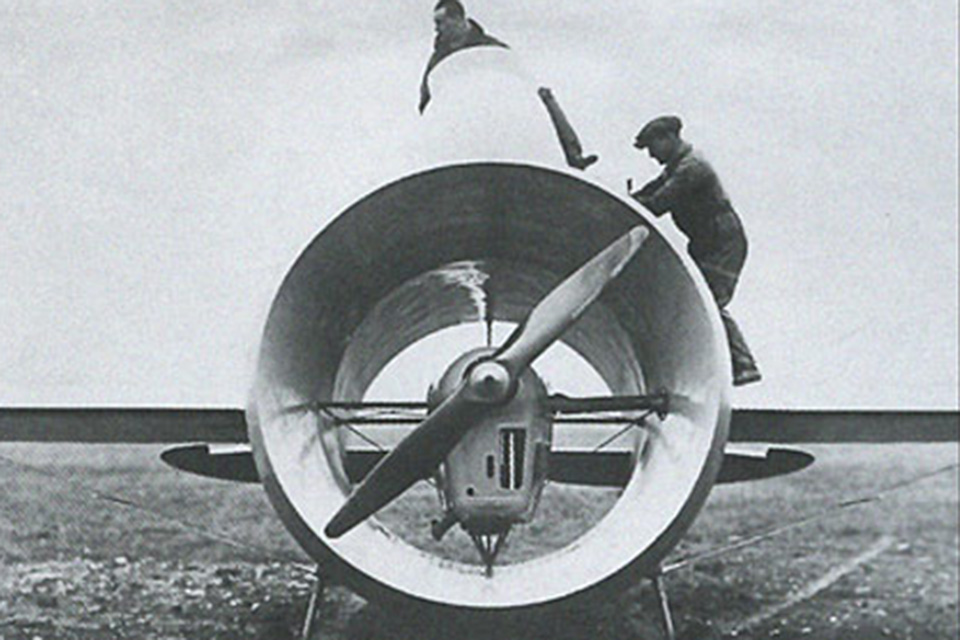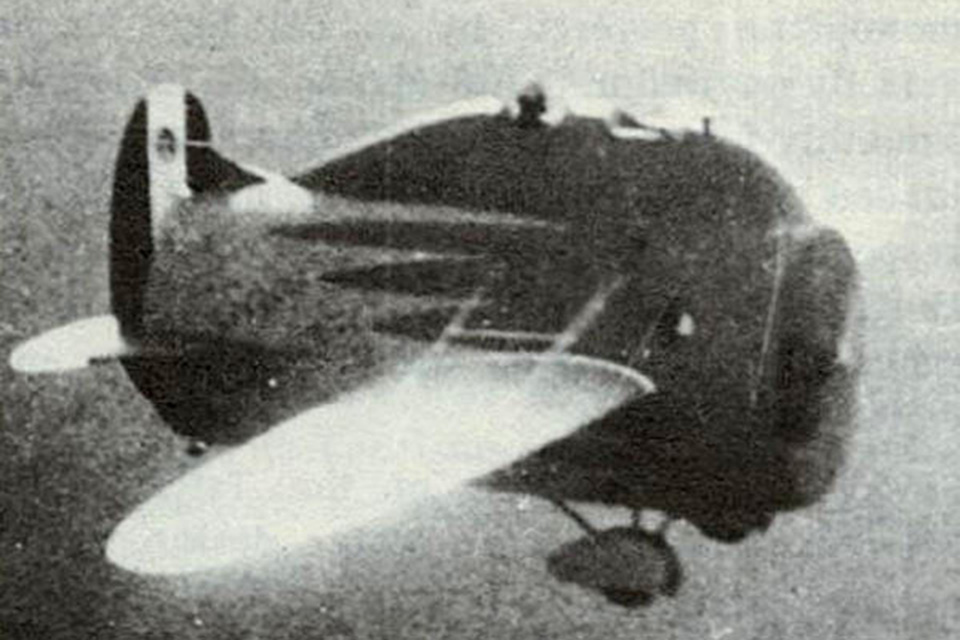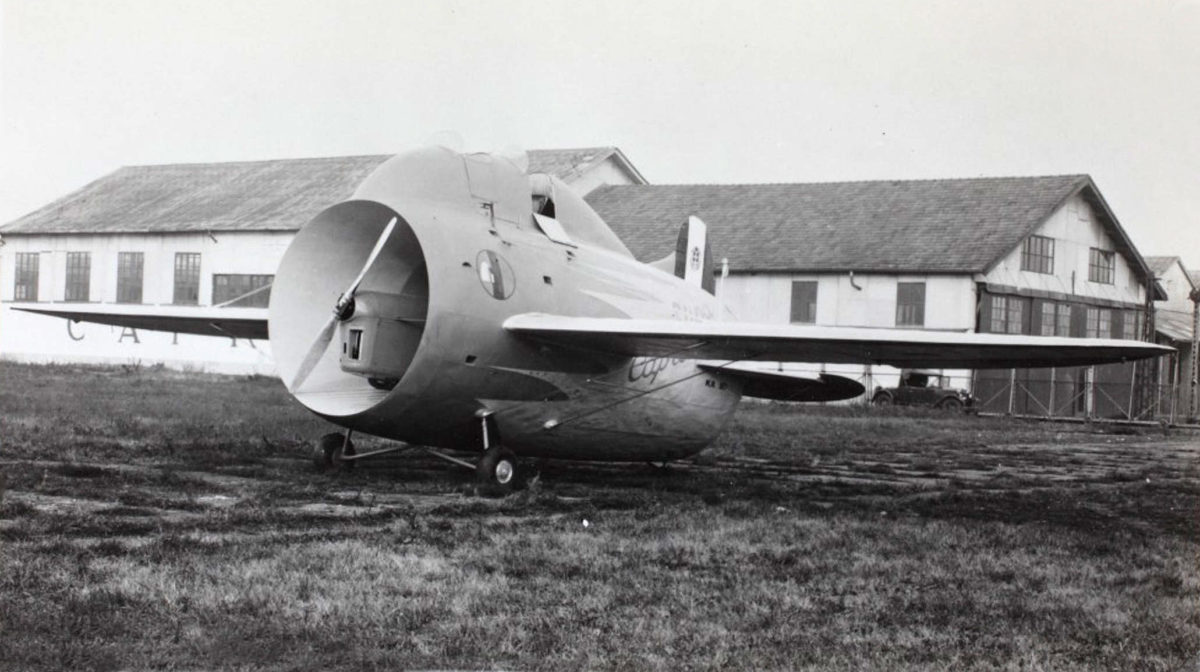Luigi Stipa claimed his ‘intubed propeller’ was the ancestor of the jet engine.
Even in an era when aircraft designers experimented with every conceivable shape and size, the prototype designed by Italian engineer Luigi Stipa and built by the Caproni company in 1932 stood apart. In place of a conventional fuselage, the airplane, known as the Caproni Stipa, consisted of a short, wide, hollow tube through which the propeller wash was directed. Today some consider the Stipa the ugliest airplane ever built. Others simply regard it as an aerodynamic freak, a sort of man-made bumblebee. There are others, however, who see in this bizarre Italian contraption the direct predecessor of the turbofan engines used on today’s commercial and military jets.
Born in 1900, Luigi Stipa interrupted his education to serve in the Italian army’s Bersaglieri Corps during World War I. He later earned degrees in civil, hydraulic and aeronautical engineering. Working for the Air Ministry, Stipa eventually became general inspector of the Air Force Engineering Division.
Stipa began to formulate a new theory on how to make aircraft more efficient. As a hydraulic engineer, he knew that the velocity of a fluid increased as the diameter of the tube through which it passed narrowed. Called Bernoulli’s principle, the relationship between the velocity and the pipe diameter was a well-understood axiom of fluid dynamics by the 1920s. Applying Bernoulli’s principle to airflow, Stipa believed he could increase the efficiency of an aircraft’s engine by directing the prop wash through a venturi tube. Stipa called his concept an “intubed propeller.” After years of crunching numbers and testing models in a wind tunnel, Stipa thought he had arrived at the optimum shapes for the prop and the tube, as well as the ideal propeller rpm and proximity between the prop and the leading edge of the tube. As it turned out, the optimum shape for the tube’s inner surface proved to be almost exactly the same as that of an airfoil.

Stipa published his findings in the Rivista Aeronautica (Aeronautical Review), along with his design for a small single-engine test bed aircraft. He then petitioned the Air Ministry to have the prototype built and flown. Despite the radical nature of Stipa’s design, at that time the Fascist government was actively encouraging technological development, particularly in aviation, to showcase Italian achievement. In 1932 the Air Ministry contracted the Caproni Aviation Corporation to construct the prototype.
Count Gianni Caproni di Taliedo had designed and built the first Italian airplane in 1910. Never afraid to push the envelope of aircraft development, early in 1914 he built the world’s first single-seat, tractor-engine fighter plane to be armed with a forward-firing machine gun. Once Italy entered World War I in May 1915, Caproni turned his attention to producing a successful series of giant aircraft.
After the war Caproni continued to create big multiwing planes, peaking with the Ca.60, an eight-engine, nine-winged airliner, as well as a full range of less ambitious designs. Clearly no one in Italy was more qualified than Caproni to build Luigi Stipa’s radical new prototype.
The Caproni Stipa must have been a startling sight when it was first flown on October 7, 1932, by Caproni test pilot Domenico Antonini. The fuselage consisted of a short, fat tube. Two tandem cockpits were located in a hump on its back. Its power plant, a single 120-hp de Havilland Gypsy III, was mounted in a nacelle suspended inside the center of the tube, with the prop located at the tube’s leading edge. Since the prop was the same diameter as the tubular fuselage, the plane squatted on a relatively low landing gear. An elliptical-shaped set of wings was mounted at mid position on the fuselage, with the main spars passing through the tube and the engine nacelle. A relatively small rudder and elevators were attached to the trailing edge of the tube, directly in the propeller’s slipstream. Capping off the plane’s outlandish appearance was its light blue and cream color scheme, similar to ones used on racing planes of the day.
Constructed mainly of wood, the Caproni Stipa was an oddly proportioned aircraft that has sometimes been compared with the Gee Bee racers. It had a wingspan of 46 feet 10 inches and was 9 feet 10 inches high, but was only 19 feet 3 inches long. Its takeoff weight was 1,764 pounds, and it had a top speed of 81 mph.
Flight-testing confirmed that the intubed propeller did, in fact, increase the engine’s efficiency. In addition, it was found that the airfoil shape of the tube’s interior contributed lift. As a result, the Stipa demonstrated a better rate of climb than conventional aircraft with similar power and wing loading, as well as a very slow landing speed of 42 mph. It also proved to be noticeably quieter than similarly powered conventional aircraft.

Stipa believed placing the control surfaces within the slipstream would aid controllability, and his creation does seem to have exhibited docile handling. But evidence indicates the rudder and elevators had to be enlarged, suggesting the designer overestimated their degree of effectiveness.
The biggest drawback to Stipa’s intubed propeller was that it produced a great deal of aerodynamic drag. In fact it became evident that, in a reasonably sized single-engine aircraft, the drag would negate almost all of the configuration’s benefits. It should be remembered, however, that the Caproni Stipa was never meant to be anything more than a test bed. Luigi Stipa seems to have intended to use his intubed propeller design not for small, single-engine planes but for large, multiengine flying wings. He produced a number of such designs, some with as many as six engines, none of which was ever built.
After initial testing, the prototype was turned over to the Italian air force, which conducted its own test program. Although the results were of great academic interest, no further development was undertaken.
The fact that the Air Ministry didn’t embrace Stipa’s theories didn’t stop the Italians from publicizing them as propaganda. Stipa patented his intubed propeller design in Germany and the United States, and his work was published in both of those countries as well as France and Britain. In the U.S. Stipa’s work was studied by NACA (the predecessor of NASA).
The French were interested enough to commission the development of a night bomber with intubed propellers based on Stipa’s design 203. Pro duced by ANFMureaux, the BN.4 night bomber would have carried a crew of four and been equipped with a retractable landing gear and two power-operated gun turrets. The plane was to have had a wingspan of 59 feet, a top speed of 233 mph, a range of 1,242 miles and a ceiling of 33,136 feet. The nationalization and reorganization of France’s aircraft industry in 1936 killed the project before a prototype was built.
Stipa later claimed the Germans stole his patented ideas when they developed their V-1 flying bomb, although the pulsejet engine actually bears little relationship to his intubed propeller. The mysterious Heinkel “T” fighter design of 1940, however, bears a strong resemblance to some of Stipa’s designs. Although little is known about the Heinkel T beyond a few drawings, it is said to have been designed for an engine developed by Viktor Schauberger, the Austrian crackpot inventor regarded as the originator of the flying saucer. In 1934 German engineer Ludwig Kort pat ented a design for a ducted fan that used principles similar to those developed by Stipa. Known as the “Kort nozzle,” this ducted fan system is still used today.
Although the Italians made no further efforts to develop Stipa’s intubed propeller, a far more advanced derivative was flown in 1940. The Caproni-Campini N.1 used a conventional radial engine to power a variable-pitch ducted fan compressor buried in the fuselage. Additional fuel was then added to the compressed air and burned in a combustion chamber in the tail. The N.1 was never efficient enough to be practical, but it did give the Italians bragging rights to having flown the first plane equipped with an afterburner.
Luigi Stipa died in 1992, embittered at not being recognized as the true inventor of the jet engine. The story of the Caproni Stipa would have ended long ago were it not for the efforts of Lynette Zuccoli and Aerotec Queensland in Australia. They built a 3/5th-scale replica of the original Caproni Stipa that has flown at least twice. The Australian Stipa has since reportedly been retired to static display.
Originally published in the March 2010 issue of Aviation History. To subscribe, click here.





